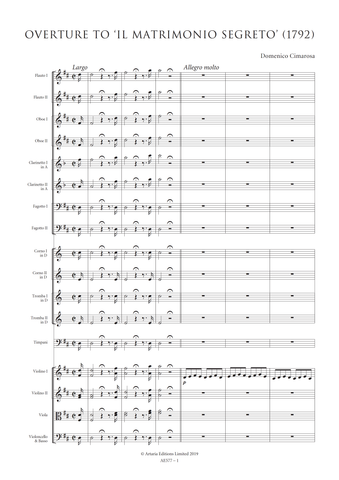Description |
Cimarosa, Domenico (1749-1801)
|
||||||||||||||||
Audio sample |
|||||||||||||||||
Details |
Written in 1778 when Cimarosa was not yet 30, L'italiana a Londra (The Italian Girl in London) proved to be the composer's first big hit. Following its prima as a five-person, two act opera at Teatro Valle in Rome on 28 December 1778, the opera was given numerous productions throughout Europe in the years that followed. By the end of the century performances had been given in German, French, Russian, Polish, Danish, Swedish and English in addition to countless productions in the original Italian. In 1979 the score was printed by G. Ricordi and innumerable contemporary productions have been mounted since then by both opera workshops and professional companies. The overture, similar to many of those by Cimarosa, shares part of its music with another overture, that to L'infedelt fedele (Faithful Infidelity) written the following spring for the opening of the new buffa theatre in Naples, Teatro del Fondo. Cimarosa's original overture to L'italiana a Londra, which was composed first, is in three movements: Allegro con spirito - Andante - Presto. Later, when he was composing his overture to L'infedelt fedele, a one-movement overture, the composer borrowed 63 bars from the 149 bars of the first movement of L'italiana a Londra to create a longer single movement (194 bars) for the new work. Giuseppe Petrosellini's libretto for L'italiana a Londra is essentially a comic love story. Livia, a humble yet courageous girl, goes to London under the false name of Enrichetta to find her sweetheart,Milord Arespingh who is being forced by his father to abandon her and, instead, marry a girl of his own rank. The Neapolitan Don Polidoro and the Dutch merchant Sumers are staying at the London inn of Madame Brillante where Arespingh is also in residence. In addition to Arespingh (who is fighting against his filial duty to marry a person of station), both Sumers and Polidoro have fallen in love with Livia, Madame Brillante's house guest from Genoa. Madame Brillante is frustrated by the fact that Polidoro wants to marry Livia when she herself wants him for a husband. After many humorous situations, misunderstandings and quarrels - including the use of a 'magic stone' by Madame Brillante to make the gullible Polidoro think that Livia is invisible - Livia and Arespingh reunite while Madame Brillante's marriage proposal to Polidoro suggests that they will take up residence in his beloved Naples. Cimarosa's holograph score in the library of the Conservatorio di musica di S Pietro a Majella in Naples (Rari 1-4-1), upon which this edition is based, is scored for pairs of oboes, trumpets (in Bb) and strings. The two eighteenth-century manuscript copies of the opera in the British Library (Hirsch II.36 and H.347a) are identical to the holograph with the exception of a pair a horns parts (also in Bb) which have been added to the trumpet staff. As is the case with all Cimarosa's autograph material the overture to L'italiana a Londra shows signs of having been composed at breakneck speed. Every conceivable notational shortcut is taken and his placement of articulation and dynamic markings is erratic. It has been necessary, therefore, to frequently interpret the composer's intentions and even at times to impose an editorial solution where his own thoughts are not clear. In making sense of Cimarosa's score the style and notation of articulation and dynamic markings have been largely standardised throughout, and, where missing, markings have been reconstructed from parallel passages. These are indicated by the use of dotted slurs or brackets where appropriate. Obvious wrong notes have been corrected without comment; editorial emendations with no authority from the source are placed within brackets. Nick Rossi Allan Badley |
Loading...
Error














